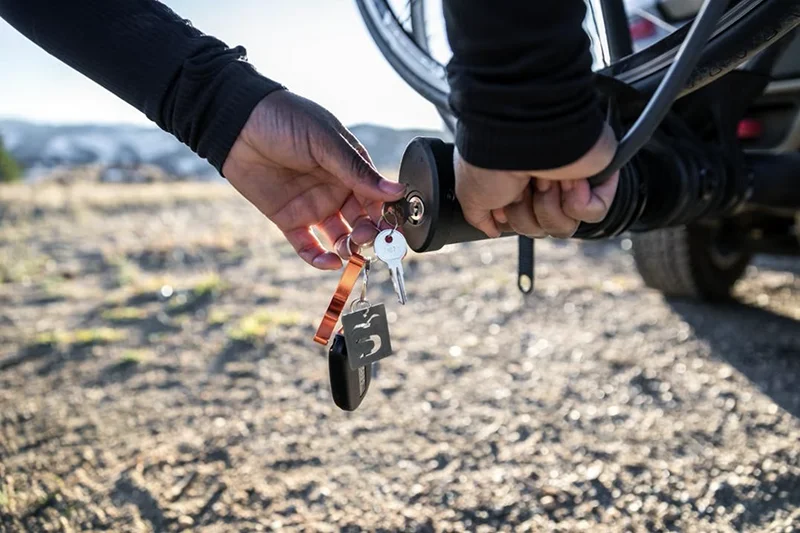Transporting an e-bike can be tricky—these bikes are heavy, bulky, and often require special handling. Loading one onto an e-bike car rack without the right tools or knowledge can lead to scratched frames, damaged racks, or even injuries. Worse, an improperly secured e-bike risks falling off during transit, posing a danger to other road users.
The good news? With the right preparation, tools, and techniques, you can load your e-bike safely and effortlessly. This guide will explain how to load an e-bike onto a car rack and walk you through everything from choosing the right rack to step-by-step loading tips, so you can hit the road with confidence and peace of mind.
Preparing Your E-Bike for Loading
Before loading your e-bike onto a car rack, taking the time to prepare it properly is essential for safety and ease. These steps not only make the process smoother but also help protect your bike and car from potential damage.
1. Remove the Battery: E-bike batteries are one of the heaviest components. Removing the battery reduces the bike’s weight significantly, making it easier to lift and load. Additionally, storing the battery separately protects it from potential damage during transport. Place the battery in a padded bag or case inside your vehicle to prevent jostling.
2. Take Off Loose Accessories: Detach any easily removable accessories like lights, baskets, or panniers. These items can add unnecessary bulk and weight, making the bike harder to secure on the rack. Removing them also reduces the risk of losing or damaging them during the journey.
3. Secure the Front Wheel and Handlebars: Use a Velcro strap or bungee cord to stabilize the front wheel and align the handlebars with the bike frame. This step prevents the wheel from turning and the handlebars from protruding, ensuring the bike fits snugly onto the rack.
4. Check the Bike’s Weight: Verify your e-bike’s weight, including any accessories that can’t be removed. This helps confirm whether your car rack can handle the load. Most e-bikes weigh between 50–75 lbs, so double-check the rack’s weight capacity to avoid overloading it.
5. Inspect the Bike for Loose Parts: Perform a quick check to ensure that all bolts, screws, and components are tightly secured. Loose parts can rattle or fall off during transport, potentially causing damage to your bike or vehicle.
By taking these preparatory steps, you’ll make loading your e-bike easier and ensure it stays secure and protected throughout your journey.
Step-by-Step Guide to Loading an E-Bike
Loading an e-bike onto a car rack may seem daunting due to its weight and size, but with the right approach, it can be done efficiently and safely. Follow these steps to ensure a smooth process:
1. Position Your Car and Rack: Park your car on a level surface and ensure the bike rack is securely installed. Double-check the rack’s locking mechanisms and weight capacity to ensure it’s ready to handle the e-bike.
2. Adjust the Rack for Your Bike: If your rack has adjustable arms or platforms, set them to match your e-bike’s dimensions. For racks with wheel trays, ensure they’re properly spaced to accommodate the bike’s wheelbase.
3. Use a Ramp (If Available): If your rack comes with a built-in ramp or you’ve purchased one separately, set it up. A ramp is invaluable for rolling the e-bike onto the rack, reducing the need for heavy lifting.
4. Lift the Bike Safely. If you need to lift the e-bike manually:
- Grip the Frame: Hold the frame securely near the down tube or seat post.
- Use Proper Technique: Bend at your knees and keep your back straight to avoid injury. Avoid holding the battery area or other fragile components.
5. Place the Bike on the Rack: Align the bike with the rack and position the tires into the designated wheel trays or slots. For hitch racks, secure the bike’s frame using the rack’s arms or clamps.
6. Secure the Wheels: Use the rack’s straps or clamps to lock the front and rear wheels in place. Ensure the straps are snug but not overly tight, avoiding damage to the tires or spokes.
7. Double-Check Alignment: Confirm that the bike is centered and aligned with the vehicle. This reduces wind resistance and ensures the load is stable.
8. Lock the Bike: Many e-bike racks come with built-in locks. Use them to secure the bike to the rack and deter theft. For added security, consider using an additional e-bike lock to secure the wheels and frame.
9. Perform a Final Check before hitting the road:
- Ensure all straps and locks are tight.
- Check that the bike doesn’t wobble when gently shaken.
- Confirm the rack itself is secure and firmly attached to the vehicle.
By following these steps, you’ll ensure your e-bike is loaded securely and ready for transport, minimizing risks and making your journey worry-free.
Pro Tips for Solo Loading
Loading an e-bike by yourself doesn’t have to be daunting. Here are five essential tips to simplify the process:
- Use a Ramp: Roll your bike up a built-in or portable ramp to avoid heavy lifting.
- Remove the Battery: Detach the battery to lighten the bike and protect it during transport.
- Leverage the Rack: Place one wheel on the rack first and use it as support to lift the other end.
- Secure with Straps: Stabilize the bike with straps as you load to prevent tipping.
- Practice at Home: Familiarize yourself with the process beforehand for a smoother experience.
Essential Safety Checks Before Hitting the Road
Before embarking on your journey, ensuring your e-bike and rack are securely in place is vital for safety. Here’s a quick checklist to follow:
1. Inspect the Rack: Confirm that the bike rack is securely attached to your car. Tighten all bolts and ensure the rack doesn’t wobble.
2. Check the Straps: Verify that all straps are snugly fastened around the e-bike’s frame and wheels, avoiding contact with sensitive components like brake lines.
3. Test Stability: Gently shake the bike to ensure it’s firmly mounted. A properly loaded bike shouldn’t shift significantly.
4. Secure Loose Items: Remove or tightly fasten any loose items on the bike, such as bags, water bottles, or lights, to prevent them from flying off during transit.
5. Battery Safety: If the battery remains on the bike, ensure it’s locked in place. Otherwise, store it securely inside your vehicle.
6. Tail Light Visibility: Check that the bike and rack don’t obstruct your car’s tail lights or license plate. Use additional lights if necessary.
Final Thoughts on Loading an E-Bike
Loading an e-bike onto a car rack may seem challenging at first, but with the right preparation, techniques, and safety measures, it becomes a straightforward task.
By choosing a suitable rack, preparing your e-bike, and following proper loading steps, you can ensure your bike remains secure throughout the journey. Don’t forget to perform essential safety checks and implement pro tips for solo loading to simplify the process.
Whether you’re heading to scenic trails or a new city, taking the time to load your e-bike correctly guarantees a safer and more enjoyable adventure.
You May Also Enjoy These Buying Guides
Still looking for your perfect e-bike? Check out our most popular reviews:
- Mid-Drive E-Bike Picks: Top Models Reviewed
- Electric Bikes with Throttle: 9 Best Throttle-Controlled E-Bikes
- Best Electric Off-Road Bikes
- Longest Range E-Bikes to Consider
- Best E-Bikes with a Bosch Motor
Featured image source: Yakima



Your Feedback is Important!